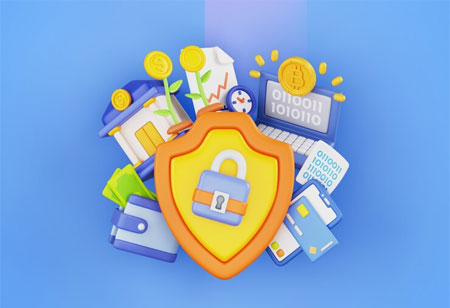.png)
Receive SMS online OTP has revolutionized the landscape of banking security, offering a robust shield against the ever-evolving threats in the digital financial world. As cyber-attacks become more sophisticated, traditional security measures are no longer sufficient to protect sensitive financial information.
The journey of banking security has been a constant race against increa- singly sophisticated threats. From physical vaults to digital fortresses, the banking industry has continuously adapted its security measures to protect assets and information.
In the early days of banking, security primarily focused on physical measures such as guards, vaults, and later, cameras. As technology advanced, so did the security measures, introducing personal identification numbers (PINs) and magnetic stripe cards.
The advent of the internet brought about a seismic shift in banking. Online banking offered unprecedented convenience but also opened new avenues for potential security breaches. This digital transformation necessitated more advanced security protocols.
SMS OTP systems emerged as a response to the growing need for stronger authentication in online banking. These systems added an extra layer of security by sending a unique code to the user's registered mobile number for each transaction or login attempt.
The concept of receiving SMS online OTPs marks a significant leap forward in banking security.
An online SMS OTP is a unique, time-sensitive code sent to a virtual phone number associated with the user's account. Unlike traditional SMS OTPs sent to physical mobile devices, these codes are received and accessed through secure online platforms.
The process involves generating a virtual phone number for the user, which is then linked to their banking account. When a transaction or login attempt is made, the bank sends an OTP to this virtual number. The user can then access this OTP through a secure online interface or app.
Online SMS OTP reception offers several advantages over traditional methods, including enhanced security against SIM swapping attacks, accessibility from multiple devices, and improved protection of personal phone numbers.
The transition to online SMS OTP systems requires careful planning and execution. This section outlines the key considerations for banks looking to implement this technology.
Implementing online SMS OTP systems necessitates robust backend infrastructure, secure APIs for integration with existing banking systems, and user-friendly interfaces for customers to access their virtual numbers and OTPs.
The integration process typically involves partnering with a reliable virtual number provider, modifying existing authentication systems, and extensive testing to ensure seamless functionality and security.
Banks must prioritize user experience when implementing online SMS OTP systems. This includes providing clear instructions, offering responsive customer support, and ensuring the system is intuitive and easy to use for all customers.
Online SMS OTP systems come with a host of advanced security features that significantly bolster the overall security posture of online banking platforms.
By combining online SMS OTPs with other authentication factors such as biometrics or knowledge-based questions, banks can create a formidable multi-layered defense against unauthorized access.
Advanced encryption protocols ensure that OTPs and other sensitive information remain secure throughout the transmission process, from generation to reception by the user.
Sophisticated monitoring systems can detect unusual patterns or suspicious activities in real-time, triggering immediate alerts and preventive measures to thwart potential security threats.
Real-world examples demonstrate the tangible benefits of implementing online SMS OTP systems in banking environments.
A leading international bank reported a 60% reduction in fraudulent transactions within six months of implementing an online SMS OTP system, saving millions in potential losses.
A regional bank saw a 40% increase in customer satisfaction scores related to security after introducing online SMS OTP, with customers reporting feeling more confident in their online banking activities.
A global financial institution successfully used online SMS OTP to facilitate secure international transactions, reducing verification times by 70% and significantly improving the customer experience for travelers and expats.
While online SMS OTP systems offer numerous benefits, it's crucial to address potential concerns to ensure widespread adoption and trust.
Banks must navigate complex regulatory landscapes to ensure their online SMS OTP systems comply with data protection laws and industry standards.
Ensuring that online SMS OTP systems are accessible to all users, including those with disabilities or limited technical knowledge, is crucial for inclusive banking practices.
Implementing reliable backup authentication methods is essential to prevent account lockouts and ensure continuous access for users in case of technical issues with the online SMS OTP system.
As technology continues to evolve, so too will the capabilities and applications of online SMS OTP systems in banking.
The future may see a seamless integration of online SMS OTP with advanced biometric authentication methods, creating an even more secure and user-friendly banking experience.
Artificial intelligence could enhance online SMS OTP systems by predicting and preemptively addressing potential security threats based on user behavior and transaction patterns.
Blockchain technology may pave the way for decentralized OTP systems, offering enhanced security and transparency in the authentication process.
 Conclusion
ConclusionThe adoption of online SMS OTP systems represents a significant leap forward in banking security. By providing a robust, flexible, and user-friendly authenti- cation method, this technology addresses many of the security challenges faced by modern financial institutions. As cyber threats continue to evolve, the importance of innovative security measures like online SMS OTP cannot be overstated.
For banks, implementing this technology is not just about enhancing security—it's about building trust, improving customer experience, and staying ahead in an increasingly competitive digital landscape. For customers, it offers peace of mind and greater control over their financial security.
We use cookies to ensure you get the best experience on our website. Read more...